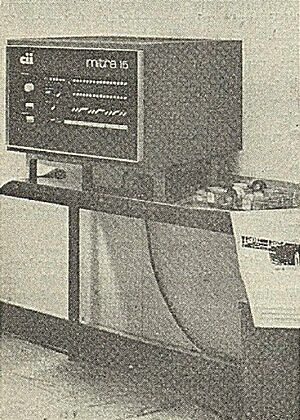Alice Recoque facts for kids
Quick facts for kids
Alice Recoque
|
|
|---|---|
| Born |
Alice Arnaud
29 August 1929 Cherchell, Algeria
|
| Died | January 28, 2021 (aged 91) |
| Nationality | French |
| Education | École supérieure de physique et de chimie industrielles |
| Occupation | Computer Scientist, Computer Engineer |
Alice Recoque (born Arnaud; 29 August 1929 – 28 January 2021) was a French computer scientist. She was also a computer engineer and an expert in computer architecture. In the 1970s, she worked on designing mini-computers. Later, she led important research in artificial intelligence.
Contents
Early Life and Education
Alice Arnaud was born on August 29, 1929. Her birthplace was Cherchell, in Algeria. In 1954, she graduated from the École supérieure de physique et de chimie industrielles. She earned a degree as a graduate engineer.
Her Career in Computing
Alice Recoque began her career in 1954. She worked at a company called Société d'électronique et d'automatisme (SAE). There, she helped develop core memories for early computers.
In 1956, Alice Recoque and Françoise Becquet started an exciting project. They designed the CAB500 mini-computer. This was the first "conversational desktop computer." It was released in 1960. The CAB500 was a French, low-cost mini-computer. Its main goal was to perform complex scientific calculations. She also worked on the CINA industrial computer. She co-led the CAB 1500 project, which used the Algol programming language.
Working at CII
In 1966, SAE merged with another company, CAE. This created the Compagnie internationale pour l'informatique (CII). Alice Recoque continued her work at CII. She helped design the Mitra computers. The first model, Mitra 15, was launched in 1972. Both the Mitra 15 and CAB500 were very successful in France.
Alice Recoque was asked to develop a new project. This project focused on small computers. These computers were for industrial and scientific uses. They would complete the range of IRIS mainframe computers. These larger computers were mostly for business management. Alice Recoque became the head of research and development for CII's "Small Computers" division. She led the Mitra 15 project until it was ready for production.
Protecting Data Privacy
In 1978, Alice Recoque helped create the National Commission for Data Processing and Liberties. She was worried about how companies and governments could watch people more easily. She believed there needed to be rules to protect people's privacy.
Leading Artificial Intelligence Research
In 1985, the Bull Group focused on new research. This included highly parallel machines and artificial intelligence. Alice Recoque was appointed director of the "Artificial Intelligence" mission. She expanded the idea of AI beyond just computer programming. She wanted to study human behavior to understand and copy it.
She worked closely with public research groups like the French National Institute for Research in Computer Science and Control (Inria). Alice Recoque led a team of over 200 people. They defined the products Bull would develop for artificial intelligence. This included creating a grammar in Prolog II to understand French language. They also designed the Knowledge representation Object-Oriented Language (KOOL). KOOL was developed in Lisp for Bull SPS-7 machines.
Teaching and Mentoring
Alice Recoque also shared her knowledge with others. She created and taught computer structure at ISEP for many years. She also taught computer science at other schools. These included the Ecole Centrale de Paris, Supélec, and the Institut Catholique de Paris.
The Mitra Computer Family
The Mitra project aimed to compete with new mini-computers. These included models like Digital Equipment Corporation's PDP-11.
Mitra Models and Success
The Mitra family included several models.
- The Mitra 15 (Mitra 15-20 and Mitra 15–30) was released in 1972.
- The Mitra 125, designed in 1975, had better memory features.
- Finally, the Mitra 225 was developed.
Almost 8,000 Mitra 15 computers were sold. Some were still in use even in the late 1990s!
Why Mitra Was Popular
The Mitra 15 was known for being powerful, strong, and reliable. It was designed to be used for many different things. This was possible thanks to an innovative system. It was first used for industrial control and scientific calculations. Soon, it was adapted for sending data. It was also used in the CYCLADES Network and in schools.
In France, the telecommunications company used Mitra computers a lot. The Mitra 15 was in telephone switches from 1972 to 1976. Then, the Mitra 125 was used from 1976. Finally, the Mitra 225 was used from 1981 until 1996. The last Mitra computers were made in 1993.
Awards and Recognition
Alice Recoque received several important awards for her work.
- In 1979, she received the Ordre national du Mérite as a Knight.
- In 1985, she was promoted to Officer of the Ordre national du Mérite.
- In 2016, she became an honorary member of the Société informatique de France.
See also
 In Spanish: Alice Recoque para niños
In Spanish: Alice Recoque para niños


